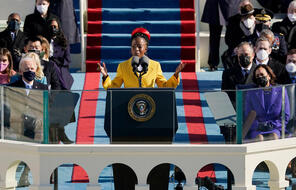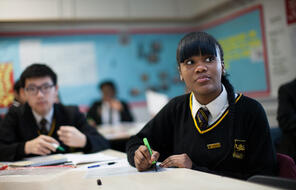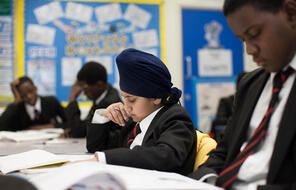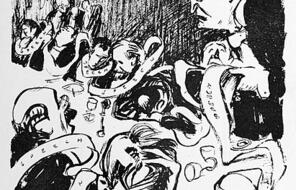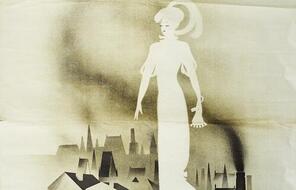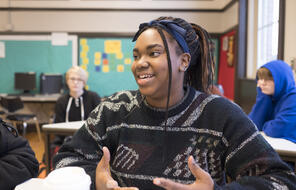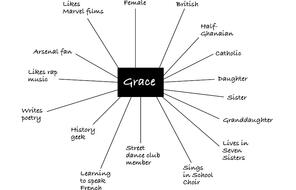Looking at Citizenship through a Literary Lens
At a Glance
Language
English — USSubject
- English & Language Arts
- Democracy & Civic Engagement
This 2017 article by Laura Tavares was published in ASCD’s Educational Leadership magazine.
The divisive election of 2016 and our tumultuous political landscape have created a new sense of urgency about civic education in American schools. Educators are urged to treat civic learning as an interdisciplinary subject to be infused throughout the curriculum, but in practice, the task of teaching these essential topics most often falls exclusively to history and social studies teachers. As schools recommit themselves to the task of educating students for democracy, we should examine the opportunities within a discipline that’s sometimes overlooked in conversations about civic education: English Language Arts.
Teachers of ELA are in a powerful position to cultivate essential civic dispositions and skills. Former President Barack Obama made this connection in a 2015 conversation with novelist Marilynne Robinson. After asking Robinson, “Are you somebody who worries about people not reading novels anymore?”, Obama went on to say, “When I think about how I understand my role as citizen, setting aside being president, and the most important set of understandings that I bring to that position of citizen, the most important stuff I’ve learned I think I’ve learned from novels.” 1 It may seem surprising that a Constitutional lawyer and elected leader who exercised political power at the highest levels would credit his understanding of citizenship to works of fiction, but Obama’s words invite us to broaden our understanding of what makes a good citizen. Social and ethical awareness, agency, empathy, humility and a tolerance for complexity are essential to positive participation in democratic societies—and educators can nurture those dispositions in the ELA classroom.
This article explores how the teaching of ELA and literature fundamentals like character, setting, perspective and point of view can engage a civic mindset. 2 Many approaches are drawn from the international educational organization Facing History & Ourselves, where my colleagues and I use case studies in literature and history to help teachers and students connect their study of the humanities with the choices they face in our own lives. As we created teaching guides for To Kill a Mockingbird, The Giver and other popular works, we explored how to activate civic dispositions through the study of literature—and the strategies we developed can be applied successfully to many other commonly-taught texts. We’ve also learned from master teachers whose curricula and daily classroom practices build students’ capacity for informed and engaged citizenship. Below, I offer three key ways to leverage the study of literature to build students’ civic skills and dispositions. 3
Foster Social Consciousness by Exploring Setting
Good citizens are alert to the world around them. They pay attention to current events in news headlines, but also bring a critical perspective to everyday life, to the norms, mores and power structures that shape their communities. Understanding the social landscape that surrounds us is the first step in cultivating a sense of the common good, and teachers can foster this kind of awareness through their approach to setting in literature. Setting goes well beyond simply establishing the time and place of a novel: it is also what authors Michael Smith and Jeffrey Wilhelm have called a “moral universe,” which includes values and taboos, in and out groups, and the “rules, constraints, possibilities, potential conflicts and possible consequences” 4 that affect the choices characters make.
In Lois Lowry’s classic dystopian novel The Giver, the young protagonist Jonas gradually learns about the true nature of his society, an orderly world where people live comfortably, free from poverty, disease and violence. Readers share Jonas’ mounting disquiet and horror as he realizes that to achieve such security, his community has given up individuality, passion, and freedom itself, and practices “Release”—the state-sanctioned murder of the elderly, the weak and the deviant. When Jonas is given the role of the “Receiver of Memory”, the only person in the community with full access to emotion, memory and conscience, he is faced with a choice: will he assume his assigned place, or will he disrupt the system? Dystopian novels like The Giver or George Orwell’s 1984 are fertile ground for exploring setting as a moral universe because the norms of the societies they portray are dramatically distorted. But all stories, from To Kill a Mockingbird to The Scarlet Letter, contain a moral universe and characters who negotiate their place within it.
Students map the moral universe of a novel through close attention to textual clues that signal the deeper nature of its setting—like the fact that “mirrors were rare” in Jonas’ community, where individuality is discouraged. When teaching realistic fiction, educators can also introduce historical sources to enhance students’ understanding of the moral universe of the story. Facing History’s Teaching Mockingbird resource, for example, includes mini-documentaries about the Jim Crow south and primary sources about eugenics to help students understand the norms and values of places like Maycomb in the 1930s. The concept of the “universe of obligation” can further extend students’ thinking about a novel’s setting. Coined by sociologist Helen Fein, the term refers to “the circle of individuals and groups toward whom obligations are owed, to whom rules apply, and whose injuries call for amends;” in other words, those people believed to have rights that are worthy of respect and protection. In Jonas’ world, only those who strictly conform are included within its circle; people who break the rules just three times are “released.” 5
By surfacing themes of belonging, power, violence and justice through literature, educators empower students to face these issues within their own communities. As students map the moral universe of a fictional community and consider its circles of obligation, they gain powerful frameworks to analyze the world of a novel and also their own world. Students can ask and answer important questions including: How does a community determine who belongs and who does not? How does a society define the “common good”? How do people challenge a community’s rules, and what are the consequences? What kind of moral universe do I live in? Questions like these are part of the dialogue between self and society which is essential to ethical and engaged citizenship.
Stimulate Agency Through the Study of Character
A sense of agency is fundamental to civic life: good citizens believe that their choices matter and feel a sense of responsibility for themselves and their world. Many of the popular novels we teach to young people are in fact dramas of agency—stories of characters coming to consciousness about their world, defining themselves in relation to the norms of their society, and making choices that shape their identity and their community. Students can develop their own sense of civic agency in dialogue with such stories. As literary critic Wayne C. Booth writes, the plots of great stories “are built out of the characters’ efforts to face moral choices. In tracing those efforts, we readers stretch our own capacities for thinking about how life should be lived.” 6
After students gain a sense of the moral universe of a work of fiction, they’re better prepared to evaluate the choices characters make within it, and to observe how characters respond when their conscience conflicts with the rules and expectations of their communities. As students read about Jonas’ disgust at the truth of “release”, or Scout Finch’s dawning awareness of the racial caste system that infuses all her relationships in Maycomb—or as they examine the tension between an individual and society in countless other works—they have the ability to see something rarely visible otherwise: “heroes and heroines in the never-ending process of justifying themselves, deceiving themselves, arguing with themselves. That is something you cannot watch in real life, where we see others only from the outside and have to infer inner states from their behavior.” 7
Character maps are one strategy to focus students’ attention on this inner dialogue between characters and their world and help students probe how and why characters choose to act. When we create character maps, we ask students to draw a full-body sketch of a character on a large piece of paper. Then they annotate the sketch using prompts that connect features of the figure’s body to qualities of the character, referencing specific details and quotations from the text:
Head: What is this character thinking about his or her society?
Eyes: What has this character seen?
Ears: What have they heard?
Mouth: What is this character saying?
Heart: What is this character feeling?
Hands: What action has this character taken in response to dilemmas they face of injustices that they see?
Feet: What might this character think and hope about the future?
When we teach Harper Lee’s To Kill a Mockingbird, we often create character maps for adults in the story, including Atticus Finch, Miss Maudie, a neighbor who quietly supports the children, and Dolphus Raymond, a minor character who pretends to be a drunk so the townspeople will turn a blind eye to his interracial family. Each character dissents from Maycomb’s moral universe in a distinct and limited way. In comparing and contrasting them, student begin to ask, What does dissent look like? What is the role of dissent in social change? Are people obligated to try to address injustices that they see? Is private or silent dissent valuable, or is it little more than bystanding? Such questions take students deeper into the themes of the novel and spur reflection on how we choose to participate in our own democracy—a reflection that can go even deeper if students create another character map, this time for themselves.
As one veteran teacher of To Kill a Mockingbird pointed out, “It's easy to imagine how righteously we, as products of this historical moment, would behave if transported back in time; it's harder and more valuable to ask what features of our current, still-imperfect, still-changing society we might stand up for or against right now. Which of the unwritten rules we and our students currently live by would we and they do well to start questioning? Hard conversation to have with kids, but if they can actually play the mental trick of imagining themselves outside of their own cultural moments, it might be the best thing they get out of the book.”
Practice Perspective Taking
Several recent studies have credited reading literature with promoting empathy and social awareness. 8 In novelist Barbara Kingsolver’s lyrical description, fiction “lifts you away from your chair and stuffs you gently down inside someone else's point of view... You could taste that person's breakfast, and love her family, and sort through her worries as your own, and know that a death in that household will be the end of the only life that someone will ever have. As important as yours. As important as mine. . . . Art is the antidote that can call us back from the edge of numbness, restoring the ability to feel for another.” 9 In an America marked by deep political and cultural divides, isolation and mistrust, perspective taking is an important civic skill that teachers can nurture through literature.
Selecting texts that represent diverse identities, experiences and points of view is an important first step. Teachers can deepen students’ engagement with those varied perspectives by asking them to imaginatively enter the experience and worldview of a character with strategies like character maps (as described above), or the “Circle of Viewpoints” and “Step Inside” thinking routines developed by the authors of Making Thinking Visible. 10 It’s equally important to consider the limitations of an individual’s perspective. Michael Smith and Jeffrey Wilhelm argue that “When a character tells us a story, we have to be alert for what the character can really know… We still need to think about what couldn’t or didn’t get told from that point of view." 11 Readers of To Kill a Mockingbird, for example, need to be aware of young Scout’s naivete and the extent to which she doesn’t fully understand many events she witnesses, like the attempted lynching of Tom Robinson. Students must step outside of a narrator’s perspective, and ask themselves, “What questions do I have for the narrator? What do I see that she may not? What more do I need to know to understand her world?” To complement Scout’s perspective in Mockingbird, we use oral histories of African American sharecroppers and domestic workers whose stories give us deeper insight into the experiences of Tom and Calpurnia. Students then rewrite a scene from the point of view of one of these characters.
Teachers working with almost any text can create a similar experience for their students by identifying the limitations in a narrator’s point of view and offering complementary sources to augment it. Or teachers can select a novel that is structured around shifting perspectives, like All American Boys, a new work with themes of race and justice not unlike Mockingbird. Authors Jason Reynolds and Brendan Kiely write from the point of view of two teens—one black, one white— who witness an act of police violence. The structure of the novel, which alternates between the distinct voices of the two boys, dramatizes the problem of perspective in literature and in life.
There’s a larger civic value in such reading and teaching. When students reflect on perspective, they practice empathy, but they also develop humility. As one teacher wrote, “I think stories have the greatest potential to reveal human truths in deep and powerful ways. So acknowledging the limited perspective of the narrator in a work of fiction can bridge the way for us to understand our own limited perspective as human beings.” Another said, “Can we believe our own eyes and ears? Can we believe our own stories—the ones we tell to ourselves and others? Are we unreliable narrators of our own lives?” By fostering this kind of willingness to question ourselves, reading literature lays a foundation for tolerance and civil discourse.
Finding the Civic Purpose of Literary Analysis
Educators are sometimes criticized for instrumentalizing literature, treating it as vehicle for superficial messages or an occasion for “moral blather.” 12 These strategies for examining character, setting and point of view provide a rich alternative that helps teachers bring a sense of civic urgency into the ELA classroom without sacrificing close attention to the literary qualities of the texts they teach. My experience suggests that students gain the most personal and civic insight when we use stories to surface complex questions, not offer simple answers. Most important, in my view, is the teacher’s own recognition that the ELA classroom can contribute to civic education—not, perhaps, by teaching the structure of government or the principles of collective action, but by doing the equally necessary work of educating the heart and conscience for democracy.
- 1President Barack Obama and Marilynne Robinson: A Conversation - II, The New York Review of Books, November 19, 2015. Accessed June 19, 2017.
- 2All students, regardless of their legal status, should have the chance to develop a civic mindset; in this article, “citizens” refers to all people who are part of a community, independent of their documentation.
- 3The discussion of civic dispositions in this article draws on the Campaign for the Civic Mission of Schools’ list of Civic Competencies, Accessed June 22, 2017.
- 4Michael W. Smith and Jeffrey D. Wilhelm, Fresh Takes on Teaching Literary Elements (New York: Scholastic, 2010), 71.
- 5Helen Fein, Accounting for Genocide (New York: Free Press, 1979), 4.
- 6Wayne C. Booth, The Company We Keep: An Ethics of Fiction (Berkeley: University of California Press, 1988), 187.
- 7Gary Saul Morson, “Why College Kids Are Avoiding the Study of Literature.” Commentary, July 2, 2015.
- 8See “Reading Literary Fiction Improves Theory of Mind” in Science, 3 October 2013 and “In the Minds of Others”, in Scientific American Mind, Nov/Dec 2011.
- 9Barbara Kingsolver, High Tide in Tuscon (New York: Harper Perennial, 2003), 231–232.
- 10Ritchhart, Ron; Church, Mark; Morrison, Karin. Making Thinking Visible, Hoboken, NJ: Jossey-Bass, 2011, 171-184.
- 11Michael W. Smith and Jeffrey D. Wilhelm, Fresh Takes on Teaching Literary Elements (New York: Scholastic, 2010), 119.
- 12Francine Prose, “I Know Why the Caged Bird Cannot Read”, Harper’s, September 1999.
How to Cite This Reading
Facing History & Ourselves, "Looking at Citizenship through a Literary Lens," last updated May 21, 2021.
This reading contains text not authored by Facing History & Ourselves. See footnotes for source information.

